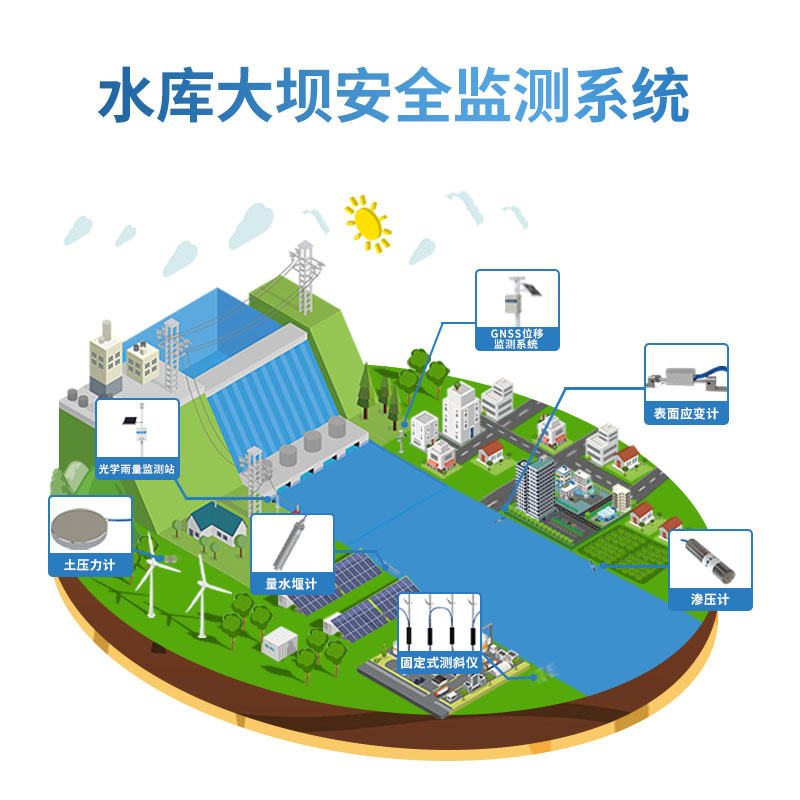Tianyi Sensor IOT Technology Co., Ltd
Sales Manager:Ms. Emily Wang
Cel,Whatsapp,Wechat:+86 15898932201
Email:info@fengtutec.com
Add:No. 155 Optoelectronic Industry Accelerator, Gaoxin District, Weifang, Shandong, China

Sales Manager:Ms. Emily Wang
Cel,Whatsapp,Wechat:+86 15898932201
Email:info@fengtutec.com
Add:No. 155 Optoelectronic Industry Accelerator, Gaoxin District, Weifang, Shandong, China

Model:FT-DB1
Brand:tianyi
1.Dam Monitoring Monitoring Background
Dam Monitoring provides a cost-effective solution for monitoring the structural behavior of dams and their surroundings.The safe flood control of reservoirs has always been a difficult and key point in my country's flood control and flood control.The safe flood control of small and medium-sized reservoirs has become a weak link in the current national flood control work.Most reservoirs lack necessary safety monitoring and other facilities, and the inspection methods are backward and there are great hidden dangers.Once local heavy rainstorms and floods occur, it is very easy to cause dam collapse.At the least, it will cause property losses, and at the worst, it will cause major casualties or devastating disasters.
As of the end of 2018, 98,822 reservoirs of various types have been built nationwide.However, most small and medium-sized reservoirs were built in the 1960s and 1970s and are trilateral projects.On the one hand, most reservoirs have low flood control standards, poor project quality, severe siltation, and shrinking effective reservoir capacity, and are in a state of operation with illness.On the other hand, many reservoirs have reached or exceeded their designed service life and are seriously aging, and the potential safety hazards of reservoir projects are prominent.
2.Overview of Dam Monitoring System
In order to achieve my country's goal of building digital water conservancy, our company took the lead in closely combining cloud computing with the Internet of Things and established an intelligent, automated and informative reservoir dam safety online monitoring system, which has functions such as remote data transmission and real-time online monitoring and early warning, which plays a crucial role in ensuring the safe operation of reservoir dams.
3.Main monitoring content of Dam Monitoring
1.Surface displacement monitoring
2.Internal displacement monitoring
3.Groundwater level monitoring
4.Rainfall monitoring
5.Retaining wall pressure monitoring
6.Concrete stress monitoring
7.Seepage flow monitoring
8.Temperature and humidity monitoring
4.Dam Monitoring monitoring project list
| Monitoring items | Device name |
| Surface displacement | GNSS |
| Internal displacement | Series fixed inclinometer |
| Groundwater level | Pore water pressure gauge |
| Rainfall | Rain gauge |
| Retaining wall pressure | Soil pressure gauge |
| Concrete stress | Strain gauge |
| Seepage | Water meter |
| Temperature and humidity | Temperature and humidity sensor |
5.Dam Monitoring Monitoring Base
"Technical Specifications for Safety Monitoring of Concrete Dam DL/T 5178-2016"
"Technical Specifications for Safety Monitoring of Earth and Rock Dam SL551-2012"
"Technical Specifications for Safety Monitoring of Concrete Dam SL601-2013"
6.Dam Monitoring implements functions
1.The data can be displayed graphically, including water level flow relationship, water level process line, rainfall bar chart, osmotic pressure and seepage process line, time history curve chart, simulation chart, histogram, histogram, and other forms.
2.Real-time monitoring can be carried out in all weather conditions.
3.Once the monitoring data exceeds the preset value, timely warnings and notify relevant units to take corresponding measures immediately.
Traditional meteorological monitoring stations are relatively fixed in distribution, making it difficult to comprehensively cover complex terrains and vast areas. There are also certain limitations in the timeliness of data. Mobile meteorological monitoring can flexibly penetrate different regions t...
Against the backdrop of climate change, extreme rainfall events are becoming increasingly frequent, posing severe challenges to flood control and drought relief work. As an important technical means to address these challenges, the rainfall monitoring station is playing an increasingly significant r...
With the rapid advancement of urbanization, construction sites, road works, and material storage yards are scattered across various corners of cities. During construction and operation, these sites inevitably generate environmental pollutants: dust and noise.A dust detector is an intelligent d...
Microwaves refer to electromagnetic waves with frequencies ranging from 300MHz to 300GHz and wavelengths from 1 millimeter to 1 meter. Due to their high frequency and short wavelength, they have strong directivity and penetrating power, enabling stable propagation under different meteorological cond...